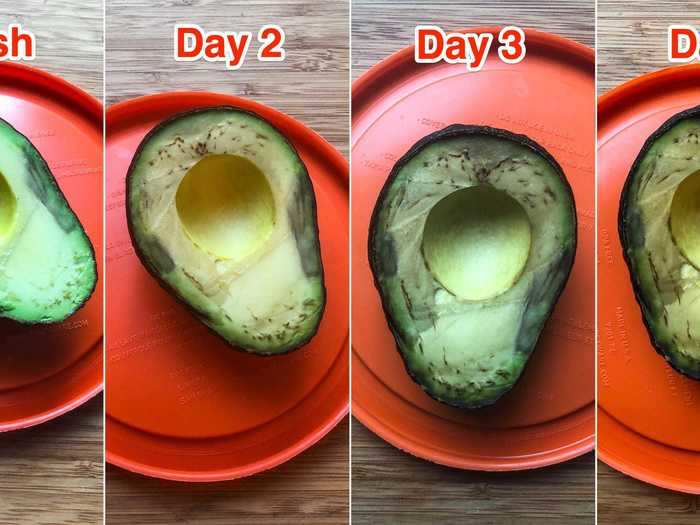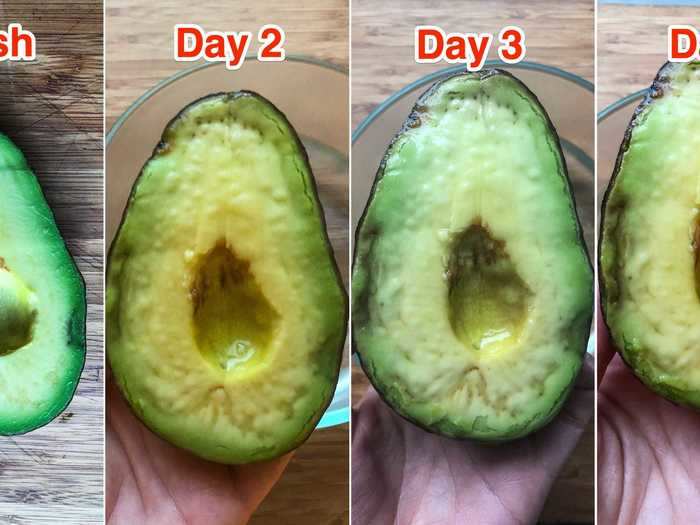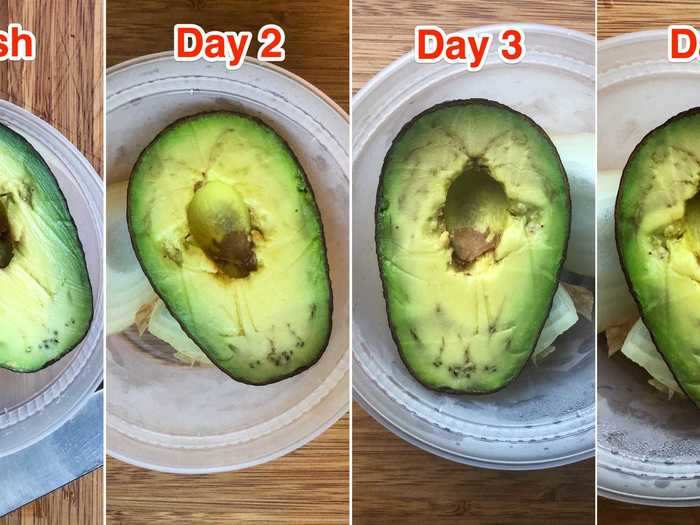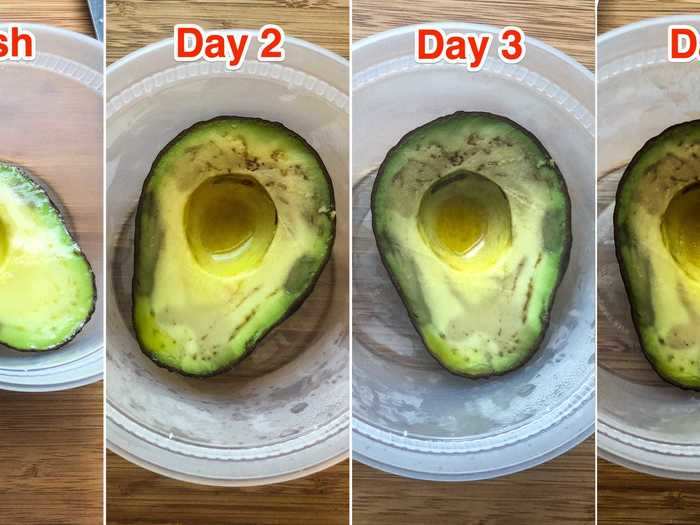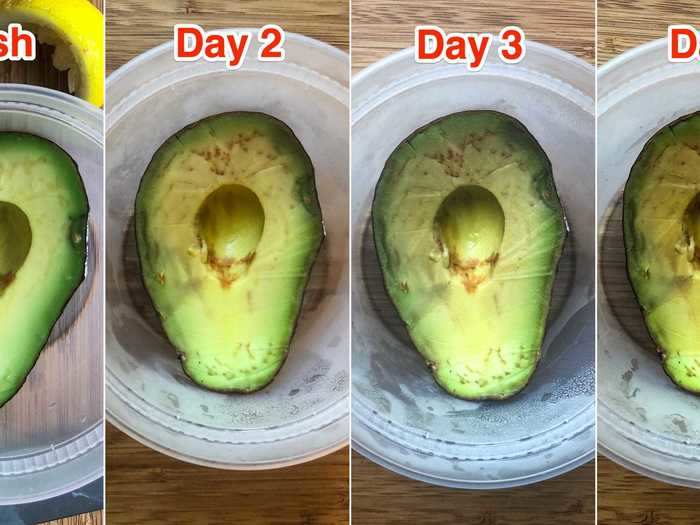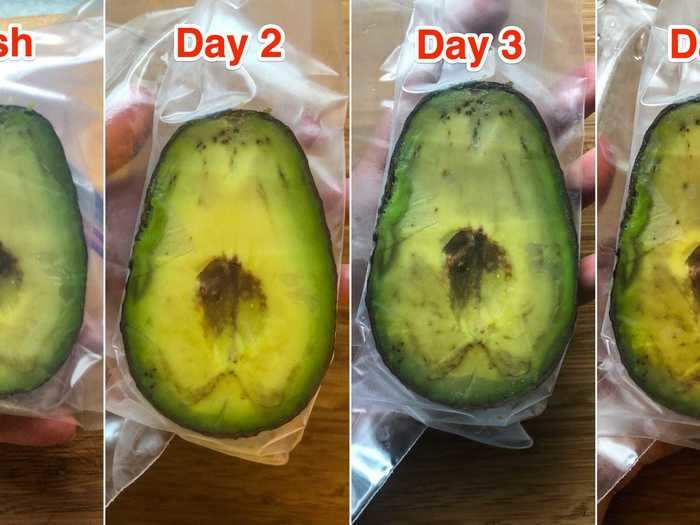Insider
- I tried storing avocados in the refrigerator five different ways to see which kept the fruit freshest over the course of four days.
- Among the suggestions I found were tricks like brushing the fruit's flesh with either olive oil or lemon juice, submerging it in water, storing it with an onion, or covering the flesh with plastic.
- I also tried leaving the fruit uncovered to compare the outcomes.
- Out of all the hacks I tried, I think using plastic or another cling material against the flesh was the best way to keep the fruit moist and green.
Storing a cut avocado has always been a guessing game for me. Should I leave the pit in? Should I douse it in lemon juice? Is cling wrap or aluminum foil better? I usually come out of the predicament with a usable piece of fruit, but I always wonder if there's a better way.
Recently, TikTok user @KMag1 showed followers how to use a bowl of water to keep the avocado bright green. Insider's Darcy Schild found success with this unconventional storage hack, so I wanted to compare it to some other popular tricks I've seen.
After scouring the internet for different tips, I came up with a list of five to test and rank in order of worst to best based on how well-preserved the avocado was after four days. To keep things consistent, I stored each avocado half without a pit, and I kept one flesh-side up and free of wrapping to see what happens if left alone.
Unsurprisingly, I think that leaving the avocado uncovered and cut-side up is the worst way to store the fruit unless you eat it within 24 hours.
The edges of this avocado turned black after day three.
Rachel Askinasi/Insider
I expected this avocado to turn brown within hours of putting it in the refrigerator, but it only started to change color after the first full day. The edges didn't turn black until the end of the avocado's third day in the fridge, and the pit crater stayed green through the end of day four.
I tasted the avocado on the final day and found its texture normal. The color was still green under the surface. Though the color held up longer than I expected, this avocado did dry out faster than the others. I was still able to cut the flesh into slices, but it was noticeably dry toward the surface.
I thought this was a perfectly fine avocado that I would happily put on a sandwich, but it wasn't as good as the others.
Submerging the avocado cut-side down in an uncovered bowl of water came in at No. 5 in this ranking.
This waterlogged avocado was mushy throughout.
Rachel Askinasi/Insider
This avocado was visibly swollen after 24 hours, and it continued to swell as the days went on. The water this was stored in turned a darker brown with each day as well.
Although this avocado stayed green in color, the water seemed to make it mushy throughout. I thought the flavor was slightly muted, which was somewhat disappointing.
Both a lack of flavor and the waterlogged flesh landed this TikTok hack the No. 5 spot on this list.
Storing the avocado in a sealed container with a cut onion takes the No. 4 spot, as it kept the fruit green but added an onion flavor.
I was able to taste the onion after four days.
Rachel Askinasi/Insider
After researching this method, I learned that the onion contains sulfur which is said to slow oxidation (the process that turns the avocado brown in the first place), according to Well and Good.
This avocado was slow to brown over the course of four days, which I thought was impressive. Though the color stayed mostly green, the flesh dried out slightly.
By the time I cut into the fruit to eat it, the onion flavor had seeped in and I was able to taste it. Because this storage method altered the flavor of my avocado, it fell to No. 4 in this ranking.
Brushing the flesh with olive oil and storing it in a sealed container was the third-best method, in my opinion.
Oil kept the fruit moist after 24 hours, but not beyond that.
Rachel Askinasi/Insider
A thin coating of olive oil is supposed to form a protective seal over the fleshy surface of the avocado that keeps oxygen away. I found that it kind of works!
The flesh did start to darken after its first day in the fridge but stayed relatively green through the end of day four.
The only issue I had with this method was that as the days went on, the olive oil seemed to pool in the crater made by the fruit's pit, and the rest of the flesh dried out slightly.
In my opinion, the second-best hack involved brushing the avocado flesh with lemon juice and storing it in a sealed container.
Lemon juice helped the avocado retain its color.
Rachel Askinasi/Insider
Brushing lemon juice over the exposed flesh of this avocado worked brilliantly. It retained almost the exact same coloring over the course of four days and there was no liquid pooling in the pit crater.
I was unable to taste the lemon when I tried this fruit, which meant it didn't change the flavor at all.
The only reason this came in at No. 2 is that the top method kept the flesh moist for four days whereas this surface was drier to the touch.
In my opinion, the best storage method is wrapping the avocado with plastic pressed tightly against the flesh.
Plastic kept the fruit both green and moist.
Rachel Askinasi/Insider
After conducting this experiment, I've decided that keeping avocado flesh tight against a covering is the only way to retain both the natural color and moisture of this fruit.
When I pulled the avocado out of the bag on day four, the flesh was just as moist as it was when I first cut it open. The texture was consistent from the surface to the middle, which I didn't find with any of the other halves.
The flavor didn't appear to have changed at all either. In my opinion, this is the best way to store a cut avocado.

